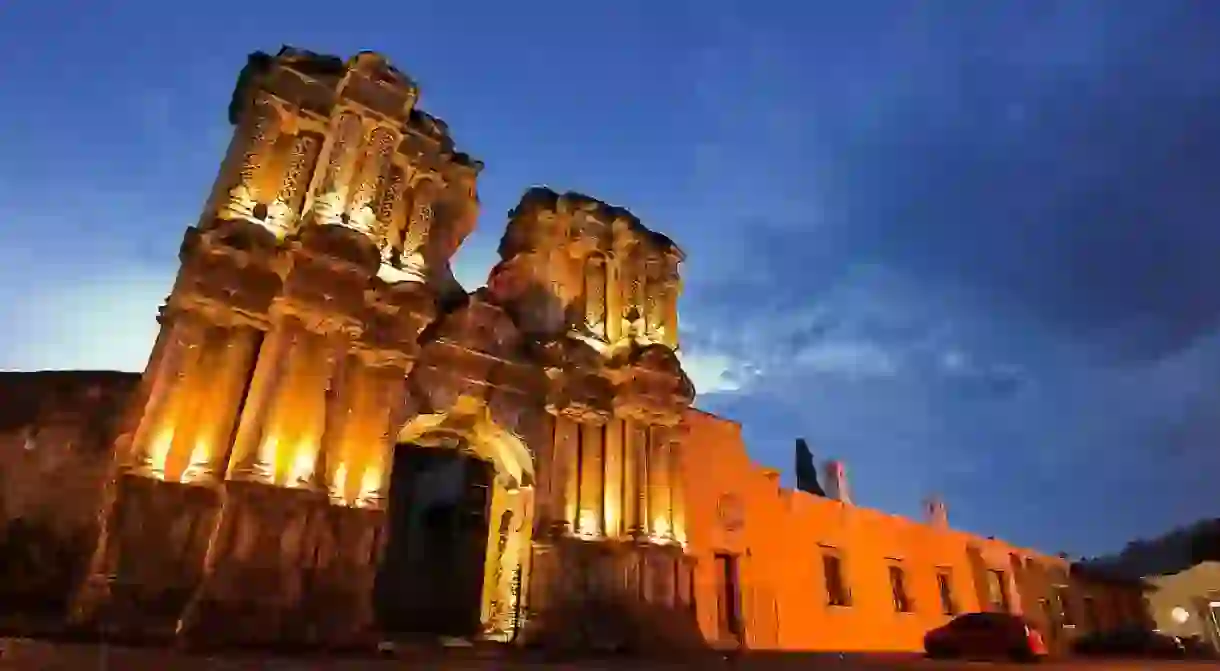A Tour of Antigua's Architectural Landmarks

First-time visitors to Antigua will be stunned by its colorful baroque architecture, cobbled streets and dramatic volcanic vistas; every time you turn a corner you have to fight the urge to pull your camera out. Colonial-era landmarks are commonplace here, but there are a few you absolutely must visit. A small and easily walkable city, Antigua is perfect to explore on foot, so here’s our guide to touring the most beautiful architectural landmarks.
San Francisco Church
Begin at San Francisco Church, the oldest active church in the city. The bell and clock towers date from the 17th and 19th centuries and, despite being partially ruined, the church is a good example of the Spanish-American baroque architectural style. The exterior features twisted salomonic columns and 16 vaulted niches, 14 of which contain a saint or friar, including the Virgin Mary, Santa Clara and Santiago. Inside the church, keep an eye out for the altarpieces, which are lavishly decorated with paintings and sculptures.

Saint Joseph Cathedral
Head to Saint Joseph Cathedral next. Originally built in 1541, it was destroyed by an earthquake and rebuilt in 1680. However, the devastating Santa Marta earthquake of 1773 (which destroyed many of Antigua’s oldest buildings) seriously damaged it once again. The front of the cathedral is still standing and is a striking specimen of colonial architecture, but walk around the front and you’ll find the haunting, roofless ruins of the main building.

Convento de las Capuchinas
The next point of interest is the convent of Las Capuchinas, which was also damaged by the earthquake of 1773 and abandoned for two centuries, despite the damage not being extensive. The convent was restored in the 1940s and remains one of the finest examples of an 18th-century convent in Guatemala. The ruins are open to the public and include several pretty courtyards and gardens, the former bathing halls and a round tower which contained the nuns’ cells.
La Merced Church
After this, head to La Merced, one of the prettiest churches in the city which boasts intricate stucco work showcasing the Moorish influence in Spain at that time. The stone cross at the atrium and the rooms behind the altar are the oldest structures, dating from the 1600s. The sanctuary, cloister, arches and columns were specifically designed to withstand earthquakes, and as a result are shorter and wider than their predecessors. The facade was designed in typical baroque style and has remained untouched apart from a fresh coat of yellow paint.

Casa Santo Domingo
Next, take a well-earned break at Casa Santo Domingo, where you can eat at the excellent restaurant or relax in the gardens with a drink. Located in the grounds of the Santo Domingo Monastery, Casa Santo Domingo was once home to one of the most important convents in the Americas. The monastery was partially destroyed in the 1773 earthquake, and what still stands has become a monument preserving the baroque architecture of the era. Now a five-star hotel, the ancient walls, brick archways and tile corridors convey the history of the original building, and the artistic masterpieces, statues and crypts have all been preserved. If you have time, pop into the hotel’s many museums.

Palacio de los Capitanes Generales
The Palace of the Captain General was once Central America’s colonial headquarters and the home of the Spanish viceroy. The original building was constructed in 1549, although several earthquakes have damaged the building over the years and the grand double-arched façade is all that’s left of the original complex. After extensive renovations, the palace is now Antigua’s cultural center, so you might be able to catch an art exhibition or live performance while you’re here.
Santa Catalina Arch
End your tour at what is arguably Antigua’s most iconic landmark – the yellow Santa Catalina Arch. Located on Calle del Arco (“street of the arch”), the Santa Catalina arch was built in 1694 to join two convents, the Convent of the Virgin and the Convent of Santa Catalina. In the 1690s cloistered nuns lived here, and because they’d taken vows of seclusion they had to avoid all contact with the outside world. The bridge served as a secret passageway for them to pass through without being seen by the public. Standing high above the cobbled streets and with the enormous Volcán de Agua behind it, the baroque style arch has become the quintessential symbol of Antigua.














